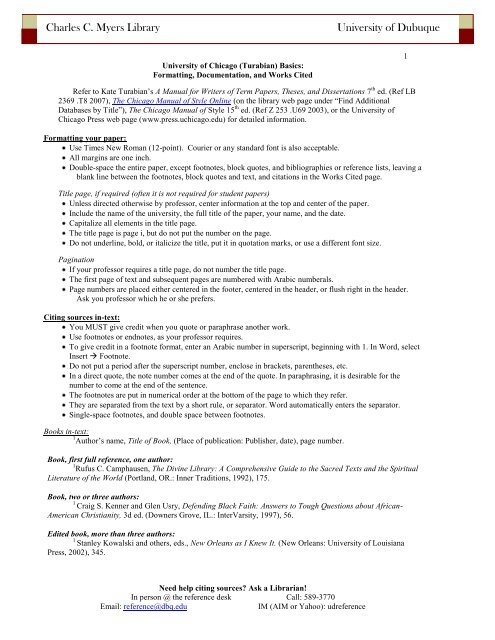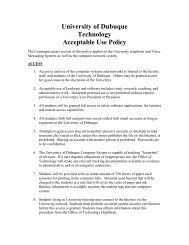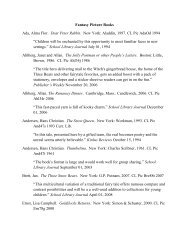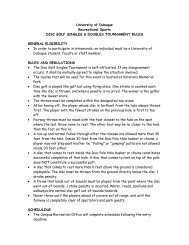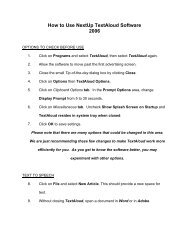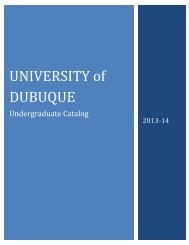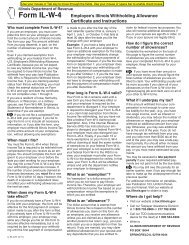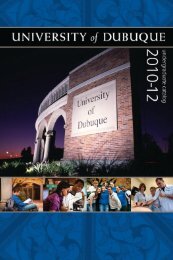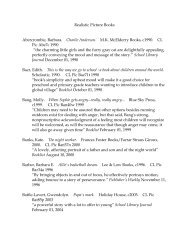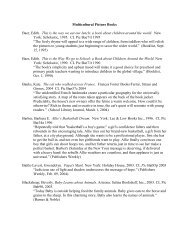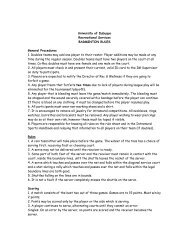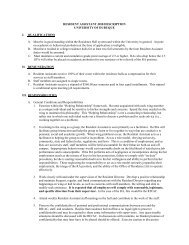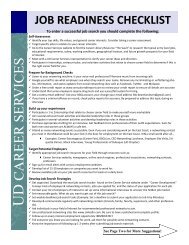Charles C. Myers Library University of Dubuque
Charles C. Myers Library University of Dubuque
Charles C. Myers Library University of Dubuque
Create successful ePaper yourself
Turn your PDF publications into a flip-book with our unique Google optimized e-Paper software.
<strong>Charles</strong> C. <strong>Myers</strong> <strong>Library</strong><br />
<strong>University</strong> <strong>of</strong> <strong>Dubuque</strong><br />
<strong>University</strong> <strong>of</strong> Chicago (Turabian) Basics:<br />
Formatting, Documentation, and Works Cited<br />
1<br />
Refer to Kate Turabian’s A Manual for Writers <strong>of</strong> Term Papers, Theses, and Dissertations 7 th ed. (Ref LB<br />
2369 .T8 2007), The Chicago Manual <strong>of</strong> Style Online (on the library web page under “Find Additional<br />
Databases by Title”), The Chicago Manual <strong>of</strong> Style 15 th ed. (Ref Z 253 .U69 2003), or the <strong>University</strong> <strong>of</strong><br />
Chicago Press web page (www.press.uchicago.edu) for detailed information.<br />
Formatting your paper:<br />
Use Times New Roman (12-point). Courier or any standard font is also acceptable.<br />
All margins are one inch.<br />
Double-space the entire paper, except footnotes, block quotes, and bibliographies or reference lists, leaving a<br />
blank line between the footnotes, block quotes and text, and citations in the Works Cited page.<br />
Title page, if required (<strong>of</strong>ten it is not required for student papers)<br />
Unless directed otherwise by pr<strong>of</strong>essor, center information at the top and center <strong>of</strong> the paper.<br />
Include the name <strong>of</strong> the university, the full title <strong>of</strong> the paper, your name, and the date.<br />
Capitalize all elements in the title page.<br />
The title page is page i, but do not put the number on the page.<br />
Do not underline, bold, or italicize the title, put it in quotation marks, or use a different font size.<br />
Pagination<br />
If your pr<strong>of</strong>essor requires a title page, do not number the title page.<br />
The first page <strong>of</strong> text and subsequent pages are numbered with Arabic numberals.<br />
Page numbers are placed either centered in the footer, centered in the header, or flush right in the header.<br />
Ask you pr<strong>of</strong>essor which he or she prefers.<br />
Citing sources in-text:<br />
You MUST give credit when you quote or paraphrase another work.<br />
Use footnotes or endnotes, as your pr<strong>of</strong>essor requires.<br />
To give credit in a footnote format, enter an Arabic number in superscript, beginning with 1. In Word, select<br />
Insert Footnote.<br />
Do not put a period after the superscript number, enclose in brackets, parentheses, etc.<br />
In a direct quote, the note number comes at the end <strong>of</strong> the quote. In paraphrasing, it is desirable for the<br />
number to come at the end <strong>of</strong> the sentence.<br />
The footnotes are put in numerical order at the bottom <strong>of</strong> the page to which they refer.<br />
They are separated from the text by a short rule, or separator. Word automatically enters the separator.<br />
Single-space footnotes, and double space between footnotes.<br />
Books in-text:<br />
1 Author’s name, Title <strong>of</strong> Book, (Place <strong>of</strong> publication: Publisher, date), page number.<br />
Book, first full reference, one author:<br />
1 Rufus C. Camphausen, The Divine <strong>Library</strong>: A Comprehensive Guide to the Sacred Texts and the Spiritual<br />
Literature <strong>of</strong> the World (Portland, OR.: Inner Traditions, 1992), 175.<br />
Book, two or three authors:<br />
1<br />
Craig S. Kenner and Glen Usry, Defending Black Faith: Answers to Tough Questions about African-<br />
American Christianity, 3d ed. (Downers Grove, IL.: InterVarsity, 1997), 56.<br />
Edited book, more than three authors:<br />
1<br />
Stanley Kowalski and others, eds., New Orleans as I Knew It. (New Orleans: <strong>University</strong> <strong>of</strong> Louisiana<br />
Press, 2002), 345.<br />
Need help citing sources? Ask a Librarian!<br />
In person @ the reference desk Call: 589-3770<br />
Email: reference@dbq.edu<br />
IM (AIM or Yahoo): udreference
Chicago basics 2<br />
Kindle:<br />
1<br />
Craig S. Kenner and Glen Usry, Defending Black Faith: Answers to Tough Questions about African-<br />
American Christianity, 3d ed. (Downers Grove, IL.: InterVarsity, 1997), Kindle, chap. 2.<br />
Subsequent references for books:<br />
Once a work has been cited completely, subsequent references are shortened.<br />
Use either a shortened title or Ibid.<br />
When the next footnote refers to the work in the footnote immediately before it, you may use Ibid. for the<br />
author’s name, title, and page, or as much information that is identical. ( 5 Ibid., 26)<br />
If the work has been cited in full, but not in the immediately preceding note, use the author, shortened title,<br />
and page number ( 3 Camphausen, Divine <strong>Library</strong>, 26) OR use only the author and page number<br />
( 3 Camphausen, 26).<br />
Periodical articles in-text:<br />
2 Author’s name, “Title <strong>of</strong> the Article,” Title <strong>of</strong> the Periodical volume (date): pages.<br />
Scholarly journal articles without issue numbers (first reference):<br />
2 Jane E. Dorweiler and John Doebley, “Development <strong>of</strong> Lyricism in Job,” Contemporary Biblical Issues<br />
84, no. 2 (2002): 461-65.<br />
Scholarly journal articles with issue numbers (first reference):<br />
2 Kenneth R. Thompson, Wayne Hockwater, and Nicholas J. Mathys, “Stretch Targets: What Makes Them<br />
Effective?” Academy <strong>of</strong> Management Executive 11, no. 3 (1999): 48-50.<br />
Scholarly journal article available online (first reference):<br />
2 Jane E. Dorweiler and John Doebley, “Lyricism in the Old Testament,” Contemporary Biblical Issues 84,<br />
no. 2 (September 2002). http://www.contemporarybiblicalissues.com/v84no2/00000.htm (accessed June 1, 2011).<br />
Subsequent references for periodicals: Omit the periodical title and shorten the article’s title, if necessary. Only use<br />
the last name if there are other works by the same author cited. ( 2 ”Stretch Targets,” 49).<br />
Magazine articles:<br />
2 Daniel Pinkwater. “The True Terrorists,” Time, 9 December 2001, 82.<br />
Web page:<br />
2<br />
Gail Mortimer, “The Women in Faulkner,” The William Faulkner Society Home Page,<br />
http://www.utep.edu/mortimer/faulkner/mail [accessed May 21, 20011].<br />
The Bible: Three options:<br />
1) Turabian 17.5.2 (p. 190-91) states references to the Bible are usually only given in footnotes, not in the<br />
Works Cited page. Include the abbreviated name <strong>of</strong> the book, chapter, and verse. Identify the version<br />
used. Example: 3 Heb. 13:8, 12 (NRSV).<br />
2) Turabian 16.4.3 (p. 157) states that “you may routinely use parenthetical notes for certain types <strong>of</strong><br />
sources, such as…a biblical or other sacred work…. Example: (Heb. 13:8 NRSV). For most such sources,<br />
you should provide a full citation in the bibliography.”<br />
3) Some pr<strong>of</strong>essors may prefer another style, such as the Student Supplement for The SBL (Society for<br />
Biblical Literature) Handbook <strong>of</strong> Style, available on the library’s web page under “For Students/Citation<br />
Styles.”
3<br />
The Works Cited Page<br />
The Works Cited page is a list <strong>of</strong> the works you used to write your paper. Your pr<strong>of</strong>essor may prefer you use<br />
the label Bibliography or Sources Consulted.<br />
Center the words WORKS CITED at the top <strong>of</strong> the page. Your pr<strong>of</strong>essor may prefer you not capitalize.<br />
Single-space bibliographic entries and double-space between entries.<br />
Alphabetize entries by the author’s last name. If there is no author, alphabetize by title.<br />
Indent the first line <strong>of</strong> each entry one-half inch (or one tab). Subsequent lines are not indented.<br />
Books in the Works Cited page:<br />
Author’s name. Title <strong>of</strong> Book. Place <strong>of</strong> publication: Publisher, date.<br />
Book, one author:<br />
Franklin, John Hope. George Washington Williams: A Biography. Chicago: <strong>University</strong> <strong>of</strong> Chicago Press,<br />
1985.<br />
Book, two authors and second edition:<br />
Lynd, Robert, and Helen Lynd. Middletown: A Study in American Culture. 2d ed. New York: Harcourt, Brace<br />
and World, 1929.<br />
Book, three or more authors (or editors):<br />
Lyon, Mary, Bryce Lyon, and Henry S. Lucas, eds. The Wardrobe Book <strong>of</strong> the London Stage in Victorian<br />
England. London: Oxford <strong>University</strong> Press, 1982.<br />
No author given:<br />
The Lottery. London: J. Watts, 1832.<br />
Kindle:<br />
Lyon, Mary, Bryce Lyon, and Henry S. Lucas, eds. The Wardrobe Book <strong>of</strong> the London Stage in Victorian<br />
England. London: Oxford <strong>University</strong> Press, 1982. Kindle edition.<br />
Articles in the Works Cited page:<br />
Author’s name. “Title <strong>of</strong> the Article.” Journal Title volume (date): pages.<br />
Scholarly journal article:<br />
Jackson, Richard. “Running Down the Up-Escalator: Regional Inequality in Papua New Guinea.” Australian<br />
Geographer 14 (May 1979): 175-84.<br />
Scholarly journal article available online:<br />
Teague, Jason Crawford. “Frames in Action.” Kairos: A Journal for Teachers <strong>of</strong> Writing in Webbed<br />
Environments 2, no. 1 (August 20, 2007). http://english.ttu.edu/kairos/2.1 (accessed May 21, 2010).<br />
Magazine article:<br />
Weber, Bruce. “The Myth Maker: The Creative Mind <strong>of</strong> Novelist E. L. Doctorow.” New York Times<br />
Magazine, 20 October 1985, 42-5.<br />
Newspaper article:<br />
Marshall, Tyler. “200 th Birthday <strong>of</strong> Grimms Celebrated.” Los Angeles Times, 15 March 1985, sect. 1A, p. 3.<br />
Web resources in the Works Cited page:<br />
Web pages:<br />
Mortimer, Gail. “The Women in Faulkner.” The William Faulkner Society Home Page.<br />
http://www.utep.edu/mortimer/faulkner/mail. (accessed May 21, 2010).


